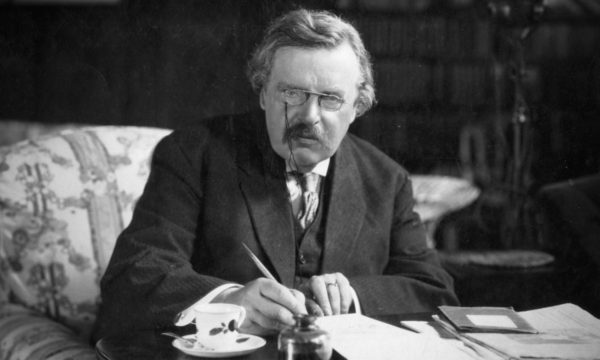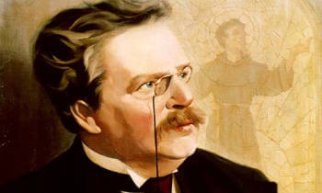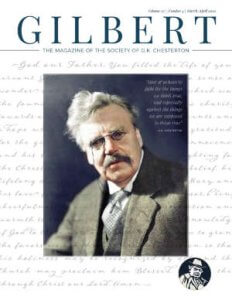QUESTION: I am trying to find out if Father Brown was partially modeled after a real priest and, if so, who?
ANSWER: Chesterton’s idea for a detective character along the lines of Father Brown had been fermenting for a period of years before the first Father Brown story published in 1910. He was a voracious, life-long reader of detective stories himself, once saying of his boyhood reading that, “If there was no murdered man under the sofa in the first chapter, I dismissed the story as tea-table twaddle, which it often really was.”
His own first attempt at writing in the genre came in 1904 when he published a series of magazine stories with a new sort of detective – funny retired judge named Basil Grant, described as “a star-gazer, a mystic, and a man who scarcely stirred out of his attic.” Part of the fun was that Grant’s brother, Rupert, was a conventional private detective whose logical deductions were inevitably checkmated by Basil’s more insightful moral wisdom.
Chesterton followed the Basil Grant series with a detective novel, The Man Who Was Thursday, a dream-like and enigmatic thriller about a poet-policeman assigned to patrol an art colony and to keep a suspicious eye on any pessimistic writers or intellectual fanatics he might find there.
In 1909 Gilbert’s brother Cecil Chesterton, who had been watching these developments with more than casual interest, noted that as Gilbert was a philosopher as well as a detective-story writer, he was therefore logically destined to write “philosophical” detective stories. Cecil was quite sure these would feature some kind of “transcendental Sherlock Holmes.” His prophecy was fulfilled when Gilbert created the character of Father Brown.
It is no secret how Gilbert finally decided to make an ordinary clergyman into his transcendental Holmes. Not then a Roman Catholic himself, he had a very good Roman Catholic friend, Father John O’Connor, a parish priest. Chesterton had assumed, as perhaps many have, that celibate priests are somehow shielded from life and from life’s full serving of evil. But priests are not shielded from evil. As we will eventually hear Father Brown say, “a man who does next to nothing but hear men’s real sins is not likely to be wholly unaware of human evil.”
Chesterton had been surprised by what he later said were Father O’Connor’s glimpses of hell. “That the Catholic Church knew more about good than I did was easy to believe,” he would write in his Autobiography. “That she knew more about evil than I did seemed incredible.” One particular occasion had brought the point home with some force. Shortly after the priest was obliged to set him straight on some harrowing point of human depravity, Chesterton happened to overhear two undergraduates complaining, with an especially sophomoric condescension, about Father O’Connor and the cloistered innocence of priests. Chesterton’s reaction, recorded thirty years later, is worth repeating.
To me, still almost shivering with the appallingly practical facts of which the priest had warned me, this comment came with such a colossal and crushing irony, that I nearly burst into a loud harsh laugh in the drawing-room. For I knew perfectly well that, as regards all the solid Satanism which the priest knew and warred against with all his life, these two Cambridge gentlemen (luckily for them) knew about as much of real evil as two babies in the same perambulator.
Chesterton adds this disclaimer, however.
I permitted myself the grave liberty of taking my friend and knocking him about; beating his hat and umbrella shapeless, untidying his clothes, punching his intelligent countenance into a condition of pudding-faced fatuity, and generally disguising Father O’Connor as Father Brown. The disguise, as I have said, was a deliberate piece of fiction.
Viewed in retrospect, the idea of a fictional priest-sleuth makes perfect sense. Part of the allure of the classic detective-story formula derives from the contrast between the murderer and the detective — between the brutality of the one and the gentility of the other. The classical Great Detective is refined and fastidious (we need only think of Holmes, Wimsey, Poirot, and Miss Marple); he traffics in vulgar atrocities but is not touched by them nor does he sink to that level, as so often do the detectives of the so-called “hard-boiled school” of crime fiction. The detective who is also a clergyman might, in theory, press this contrast even further by offering saintly goodness, rather than fastidiousness, in opposition to the depravity and outrage of the criminals and crimes.
Father O’Connor was destined to write his own memories of the origin of Father Brown in his 1937 memoir, Father Brown on Chesterton, now a book collector’s rarity. Of course O’Connor’s recollections match those given by Chesterton in his own Autobiography.





Thank you for the info